Electro-Optic Response of Polymer-Stabilized Cholesteric Liquid Crystals with Different Polymer Concentrations
Abstract
:1. Introduction
2. Experimental Section
2.1. Sample Preparation
2.2. Transmission Spectra Measurement to Characterize the Reflection Band Gap
2.3. Application of an Electric Field
2.4. Optical Pumping
3. Results and Discussion
3.1. Wavelength Tuning of the PBG in PSCLC Composites
3.2. Discussion
4. Dissymmetry Factor g(λ)
5. Conclusions
Supplementary Materials
Author Contributions
Funding
Data Availability Statement
Conflicts of Interest
References
- McPhedran, R.; Botten, L.; McOrist, J.; Asatryan, A.; de Sterke, C.M.; Nicorovici, N.A. Density of states functions for photonic crystals. Phys. Rev. E 2004, 69, 016609. [Google Scholar] [CrossRef] [PubMed]
- Dolganov, P.; Baklanova, K.; Dolganov, V.K. Optical properties and photonic density of states in one-dimensional and three-dimensional liquid-crystalline photonic crystals. Liq. Cryst. 2020, 47, 231–237. [Google Scholar] [CrossRef]
- Dolganov, P.V. Density of photonic states in cholesteric liquid crystals. Phys. Rev. E 2015, 91, 042509. [Google Scholar] [CrossRef]
- Oganesyan, K.; Gevorgyan, A.; Kocharian, A.; Vardanyan, G.; Chilingaryan, Y.S.; Santrosyan, E.; Rostovtsev, Y. On a photonic density of states of cholesteric liquid crystal cells. In Proceedings of the Liquid Crystals XVIII, San Diego, CA, USA, 17–20 August 2014; pp. 178–187. [Google Scholar]
- Mitov, M. Cholesteric liquid crystals with a broad light reflection band. Adv. Mater. 2012, 24, 6260–6276. [Google Scholar] [CrossRef]
- Lu, X.; Zhou, Z.; Ni, B.; Li, H.; Li, Y.; Li, B.; Liu, W.; Wang, Y.; Yang, Y. Tuning the circularly polarized luminescence of polymer-stabilized cholesteric liquid crystal films using chiral dopants. J. Mater. Chem. C 2022, 10, 8246–8253. [Google Scholar] [CrossRef]
- Finkelmann, H.; Kim, S.T.; Munoz, A.; Palffy-Muhoray, P.; Taheri, B. Tunable mirrorless lasing in cholesteric liquid crystalline elastomers. Adv. Mater. 2001, 13, 1069–1072. [Google Scholar] [CrossRef]
- Heilmeier, G.H.; Goldmacher, J.E. A new electric field controlled reflective optical storage effect in mixed liquid crystal systems. Proc. IEEE 1969, 57, 34–38. [Google Scholar] [CrossRef]
- Sun, C.; Lu, J. Temperature Self-Adaptive and Color-Adjustable Smart Window Based on Templated Cholesteric Liquid Crystals. Polymers 2023, 16, 82. [Google Scholar] [CrossRef]
- Lee, K.M.; Marsh, Z.M.; Crenshaw, E.P.; Tohgha, U.N.; Ambulo, C.P.; Wolf, S.M.; Carothers, K.J.; Limburg, H.N.; McConney, M.E.; Godman, N.P. Recent advances in electro-optic response of polymer-stabilized cholesteric liquid crystals. Materials 2023, 16, 2248. [Google Scholar] [CrossRef]
- Yan, Q.; Wei, Z.; Lin, P.; Cheng, Z.; Pu, M.; Huang, Z.; Lin, W. Polymer stabilized cholesteric liquid crystal particles with high thermal stability. Opt. Mater. Express 2018, 8, 1536–1550. [Google Scholar] [CrossRef]
- Chychłowski, M.S.; Kajkowska, M.; Jankiewicz, B.; Bartosewicz, B.; Woliński, T.R.; Lesiak, P. Photopolymerization of 1D photonic structures induced by nematic–isotropic phase transition in liquid crystal. Soft Matter 2023, 19, 3398–3404. [Google Scholar] [CrossRef]
- Wood, S.; Fells, J.; Elston, S.; Morris, S.J.M. Wavelength tuning of the photonic band gap of an achiral nematic liquid crystal filled into a chiral polymer scaffold. Macromolecules 2016, 49, 8643–8652. [Google Scholar] [CrossRef]
- Yang, D.-K. Electrical Color Tuning in Polymer-Stabilized Cholesteric Liquid Crystals; The Royal Society of Chemistry: London, UK, 2019. [Google Scholar]
- Wang, K.; Hu, W.; He, W.; Yang, Z.; Cao, H.; Wang, D.; Li, Y. Research Progress of Electrically Driven Multi-Stable Cholesteric Liquid Crystals. Materials 2023, 17, 136. [Google Scholar] [CrossRef] [PubMed]
- Liu, Y.; Zhang, X.; Cao, Y.; Han, R.; Li, H.; Zhao, X.; He, W.; Yang, Z.; Wang, D.; Cao, H.; et al. Preparation of polymer-stabilized cholesteric liquid crystal films capable of broadband reflection using a three-layer system of self-diffusion. Polym. Adv. Technol. 2023, 34, 3849–3858. [Google Scholar] [CrossRef]
- Zhang, B.; Lin, X.; You, Y.; Hu, X.; de Haan, L.; Zhao, W.; Zhou, G.; Yuan, D. Flexible thermal responsive infrared reflector based on cholesteric liquid crystals and polymer stabilized cholesteric liquid crystals. Opt. Express 2019, 27, 13516–13525. [Google Scholar] [CrossRef] [PubMed]
- Zhang, H.; Liu, J.; Zhao, X.; Gao, J.; Ma, C.; Zhao, Y.; Yao, R.; Miao, Z.; Shen, W. Electrically induced coloration of polymer-stabilized cholesteric liquid crystal films with broadband reflection capability for smart windows. Dye Pigment. 2022, 203, 110316. [Google Scholar] [CrossRef]
- Liu, B.-W.; Zheng, Z.-G.; Chen, X.-C.; Shen, D. Low-voltage-modulated laser based on dye-doped polymer stabilized cholesteric liquid crystal. Opt. Mater. Express 2013, 3, 519–526. [Google Scholar] [CrossRef]
- Lu, H.; Yang, L.; Xia, L.; Kong, J.; Xu, M.; Zhu, J.; Qiu, L.; Hu, Z. Band-edge-enhanced tunable random laser using a polymer-stabilised cholesteric liquid crystal. Liq. Cryst. 2021, 48, 255–262. [Google Scholar] [CrossRef]
- Furumi, S.; Yokoyama, S.; Otomo, A.; Mashiko, S. Electrical control of the structure and lasing in chiral photonic band-gap liquid crystals. Appl. Phys. Lett. 2003, 82, 16–18. [Google Scholar] [CrossRef]
- Lin, J.-D.; Zhang, Y.-S.; Lee, J.-Y.; Mo, T.-S.; Yeh, H.-C.; Lee, C.-R. Electrically tunable liquid-crystal–polymer composite laser with symmetric sandwich structure. Macromolecules 2020, 53, 913–921. [Google Scholar] [CrossRef]
- Gevorgyan, A.; Oganesyan, K.; Karapetyan, R.; Rafayelyan, M.S. The photonic density of states and the light energy density in cholesteric liquid crystal cells. Laser Phys. Lett. 2013, 10, 125802. [Google Scholar] [CrossRef]
- Dolganov, P.V.; Dolganov, V.K. Photon density of states in a cholesteric photonic crystal. JETP Lett. 2018, 108, 170–174. [Google Scholar] [CrossRef]
- Saadaoui, L.; Yang, D.; Wang, Y.; Hassan, F.; Drevensek-Olenik, I.; Zhang, X.; Gan, Z.; Li, Y.; Xu, J. Electrically Tunable Two-Color Cholesteric Laser. Polymers 2023, 15, 4656. [Google Scholar] [CrossRef] [PubMed]
- Liu, B.; Yuan, C.-L.; Hu, H.-L.; Wang, H.; Zhu, Y.-W.; Sun, P.-Z.; Li, Z.-Y.; Zheng, Z.-G.; Li, Q. Dynamically actuated soft heliconical architecture via frequency of electric fields. Nat. Commun. 2022, 13, 2712. [Google Scholar] [CrossRef] [PubMed]
- Hu, W.; Zhao, H.; Song, L.; Yang, Z.; Cao, H.; Cheng, Z.; Liu, Q.; Yang, H. Electrically controllable selective reflection of chiral nematic liquid crystal/chiral ionic liquid composites. Adv. Mater. 2010, 4, 468–472. [Google Scholar] [CrossRef] [PubMed]
- Tondiglia, V.; Natarajan, L.; Bailey, C.; Duning, M.; Sutherland, R.; Ke-Yang, D.; Voevodin, A.; White, T.; Bunning, T.J. Electrically induced bandwidth broadening in polymer stabilized cholesteric liquid crystals. J. Appl. Phys. 2011, 110, 053109. [Google Scholar] [CrossRef]
- Inoue, Y.; Yoshida, H.; Kubo, H.; Ozaki, M. Deformation-Free, Microsecond Electro-Optic Tuning of Liquid Crystals. Adv. Opt. Mater. 2013, 1, 256–263. [Google Scholar] [CrossRef]
- Borah, A.R.; Gogoi, M.; Goswami, R.; Borah, A.; Hazarika, S. Integrating amine functionalized chiral graphene oxide nanosheet onto cellulose acetate electrospun nanofiber membrane for enantioselective separation of ibuprofen. J. Membr. Sci. 2024, 693, 122329. [Google Scholar] [CrossRef]
- Chien, C.-Y.; Sheu, C.-R. Doping liquid crystal cells with photocurable monomer via holographic exposure to realize optical-scattering-free infrared phase modulators with fast response time. Crystals 2017, 7, 208. [Google Scholar] [CrossRef]
- Yang, D.-K.; Cui, Y.; Nemati, H.; Zhou, X.; Moheghi, A. Modeling aligning effect of polymer network in polymer stabilized nematic liquid crystals. J. Appl. Phys. 2013, 114, 243515. [Google Scholar] [CrossRef]
- Saadaoui, L.; Hamdi, R. Electrically tunable cholesteric liquid crystal lines defects. Opt. Mater. 2021, 114, 110960. [Google Scholar] [CrossRef]
- Li, W.-S.; Ma, L.-L.; Gong, L.-L.; Li, S.-S.; Yang, C.; Luo, B.; Hu, W.; Chen, L.-J. Interlaced cholesteric liquid crystal fingerprint textures via sequential UV-induced polymer-stabilization. Opt. Mater. Express 2016, 6, 19–28. [Google Scholar] [CrossRef]
- Yu, M.; Yang, H.; Yang, D.-K. Stabilized electrically induced Helfrich deformation and enhanced color tuning in cholesteric liquid crystals. Soft Matter 2017, 13, 8728–8735. [Google Scholar] [CrossRef]
- Lin, K.-W.; Lu, J.-Y.; Tseng, H.-Y.; Lin, C.-Y.; Huang, L.Y.; Lin, Y.-L.; Chang, H.-H.; Lin, T.-H. Study of polymer-stabilized cholesteric liquid crystals for reflective displays in active matrix driving. J. Inf. Disp. 2024, 2024, 1–8. [Google Scholar] [CrossRef]
- Inoue, Y.; Sasaki, S.; Moritake, H. High-quality tuning of cholesteric liquid crystal lasers based on polymer composite system. J. Appl. Phys. 2020, 127, 083104. [Google Scholar] [CrossRef]
- Voigt, M.; Chambers, M.; Grell, M. On the circular polarization of fluorescence from dyes dissolved in chiral nematic liquid crystals. Chem. Phys. Lett. 2001, 347, 173–177. [Google Scholar] [CrossRef]
- Xu, L.; Shi, F.; Zhao, J.; Wu, L.; Li, H.; Li, Y.; Liu, W.; Yang, Y. Circularly Polarized Luminescence of Cholesteric Liquid Crystal Polymer Networks with a Europium (III) Complex as an Emitter. ACS Appl. Mater. Interfaces 2024, 16, 15242–15250. [Google Scholar] [CrossRef] [PubMed]
- Li, Z.; Lan, R.; Bao, J.; Hu, W.; Wang, M.; Zhang, L.; Yang, H. Tunable circularly polarized luminescence with a high dissymmetry factor emitted from luminogen-bonded and electrically controlled polymer-stabilized cholesteric liquid crystals. ACS Appl. Mater. Interfaces 2022, 14, 8490–8498. [Google Scholar] [CrossRef]
- Bobrovsky, A.; Piryazev, A.; Ivanov, D.; Kozlov, M.; Utochnikova, V. Temperature-Dependent Circularly Polarized Luminescence of a Cholesteric Copolymer Doped with a Europium Complex. Polymers 2023, 15, 1344. [Google Scholar] [CrossRef]
- Albertus, P. Dual electrically and thermally responsive broadband reflectors based on polymer network stabilized chiral nematic liquid crystals: The role of crosslink density. Chem. Commun. 2016, 52, 10109–10112. [Google Scholar]
- Chen, X.; Wang, L.; Chen, Y.; Li, C.; Hou, G.; Liu, X.; Zhang, X.; He, W.; Yang, H. Broadband reflection of polymer-stabilized chiral nematic liquid crystals induced by a chiral azobenzene compound. Chem. Commun. 2014, 50, 691–694. [Google Scholar] [CrossRef] [PubMed]
- Wang, T.; Zhao, J.; Wu, L.; Liu, W.; Li, Y.; Yang, Y. Polymer-stabilized cholesteric liquid crystal films with double reflection bands prepared based on the competition between photopolymerization and photoisomerization. ACS Appl. Mater. Interfaces 2023, 15, 44314–44321. [Google Scholar] [CrossRef] [PubMed]
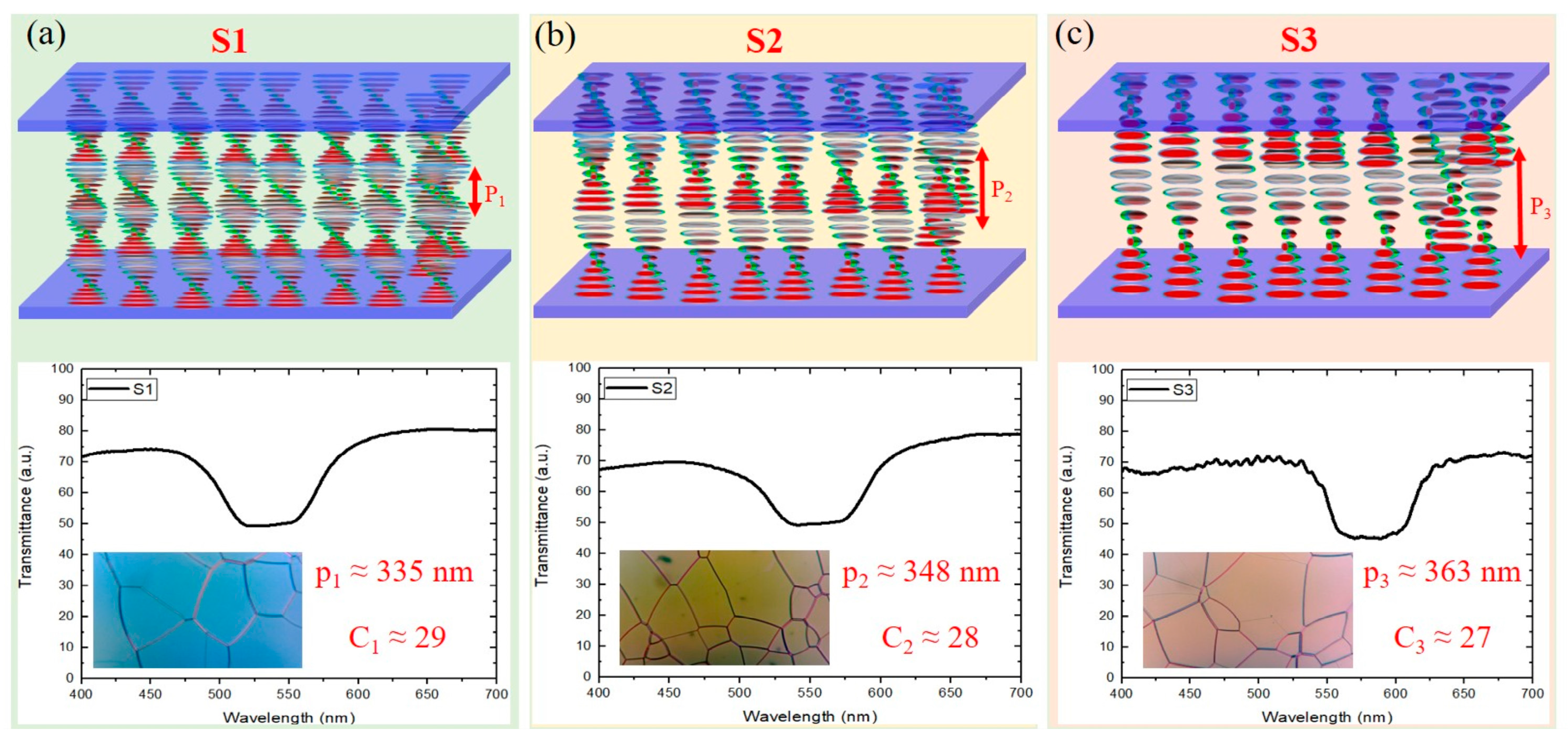
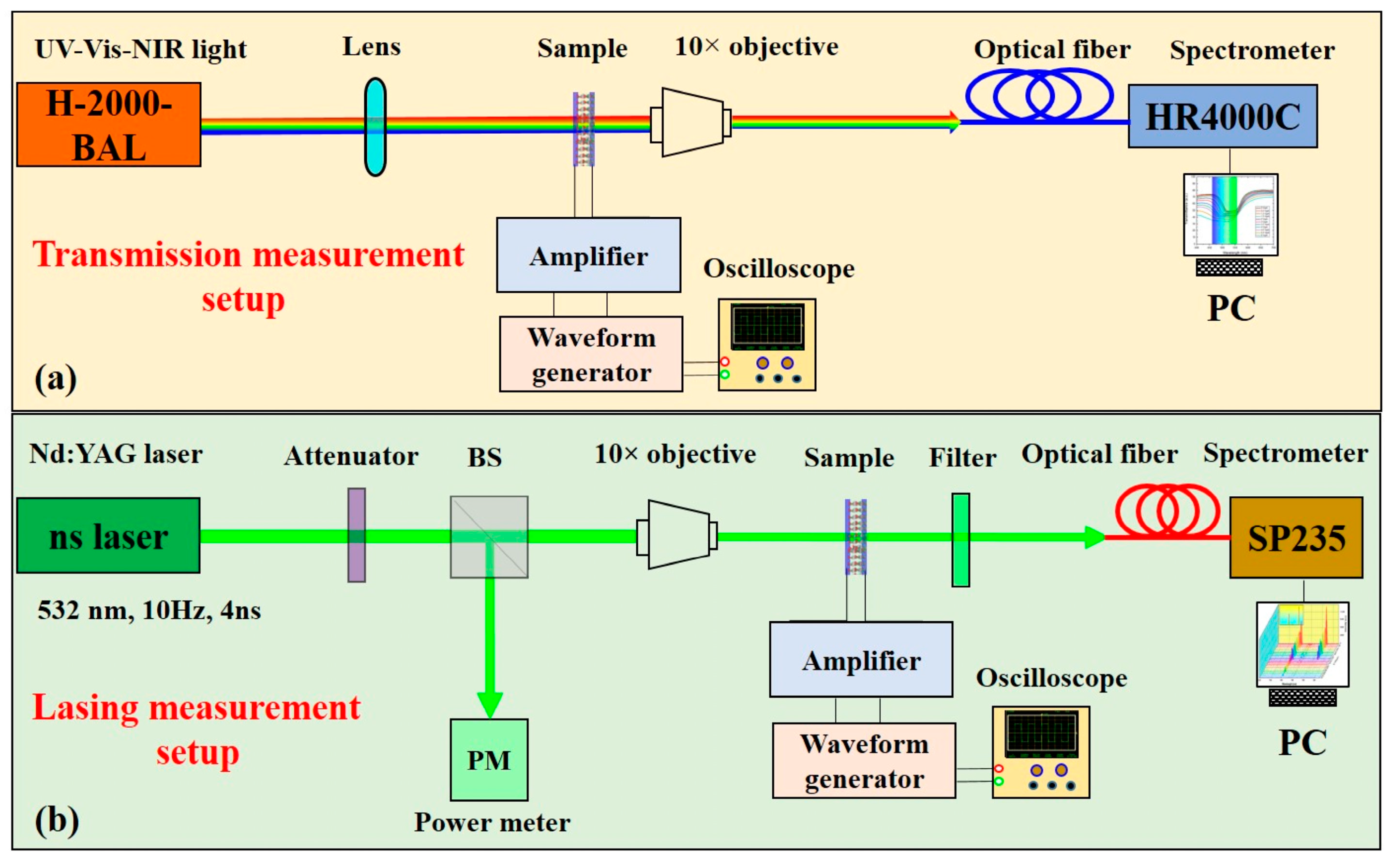
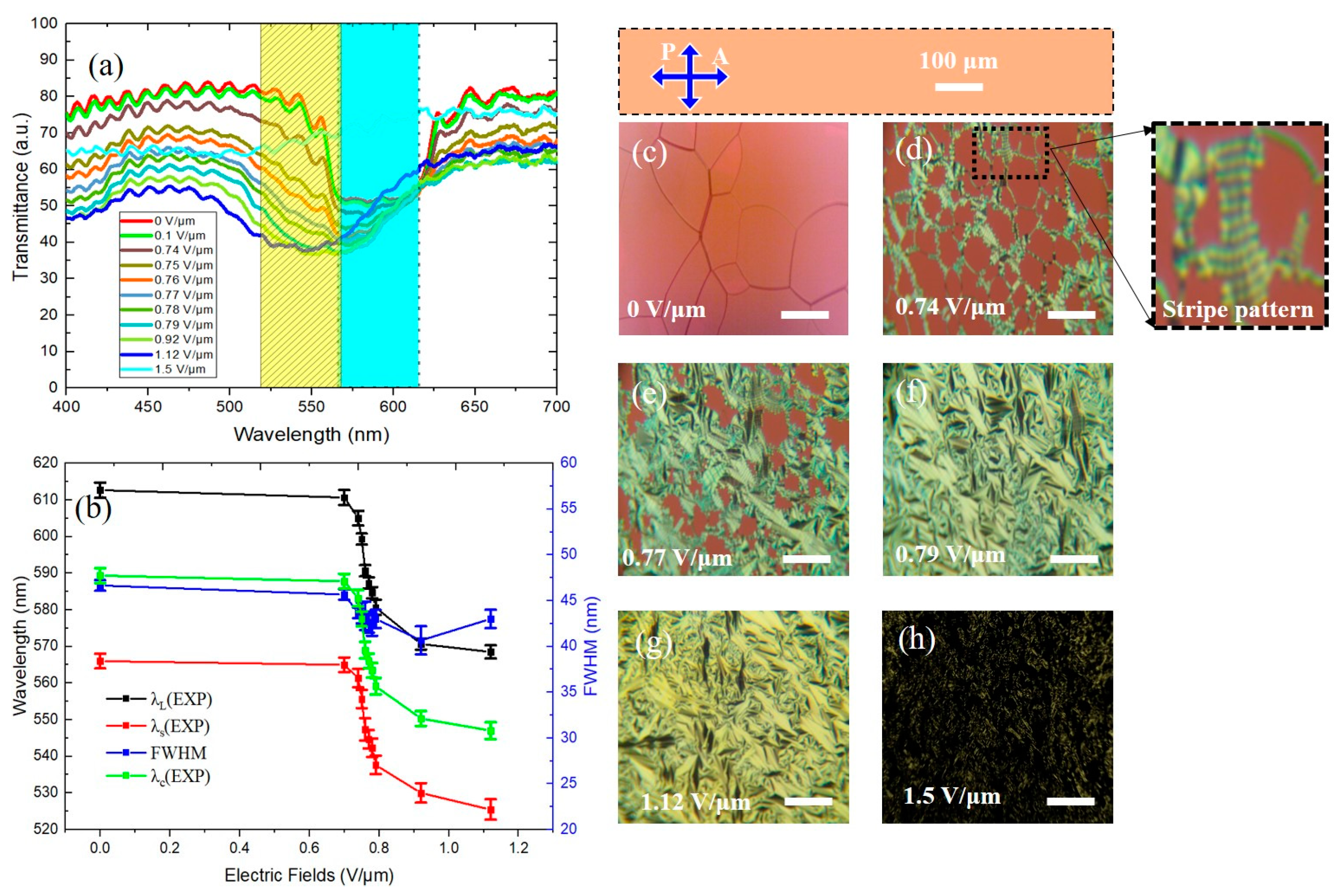

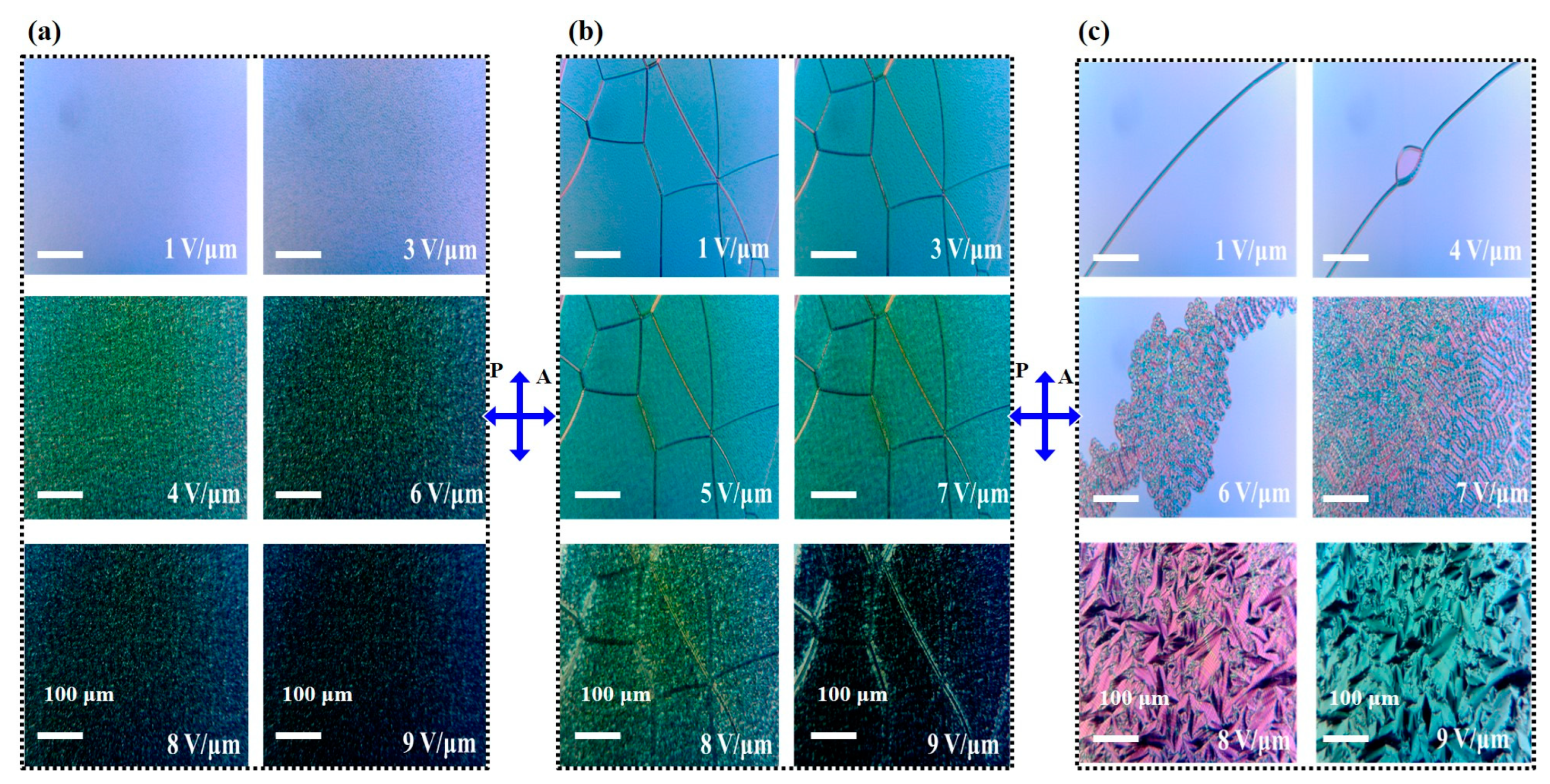
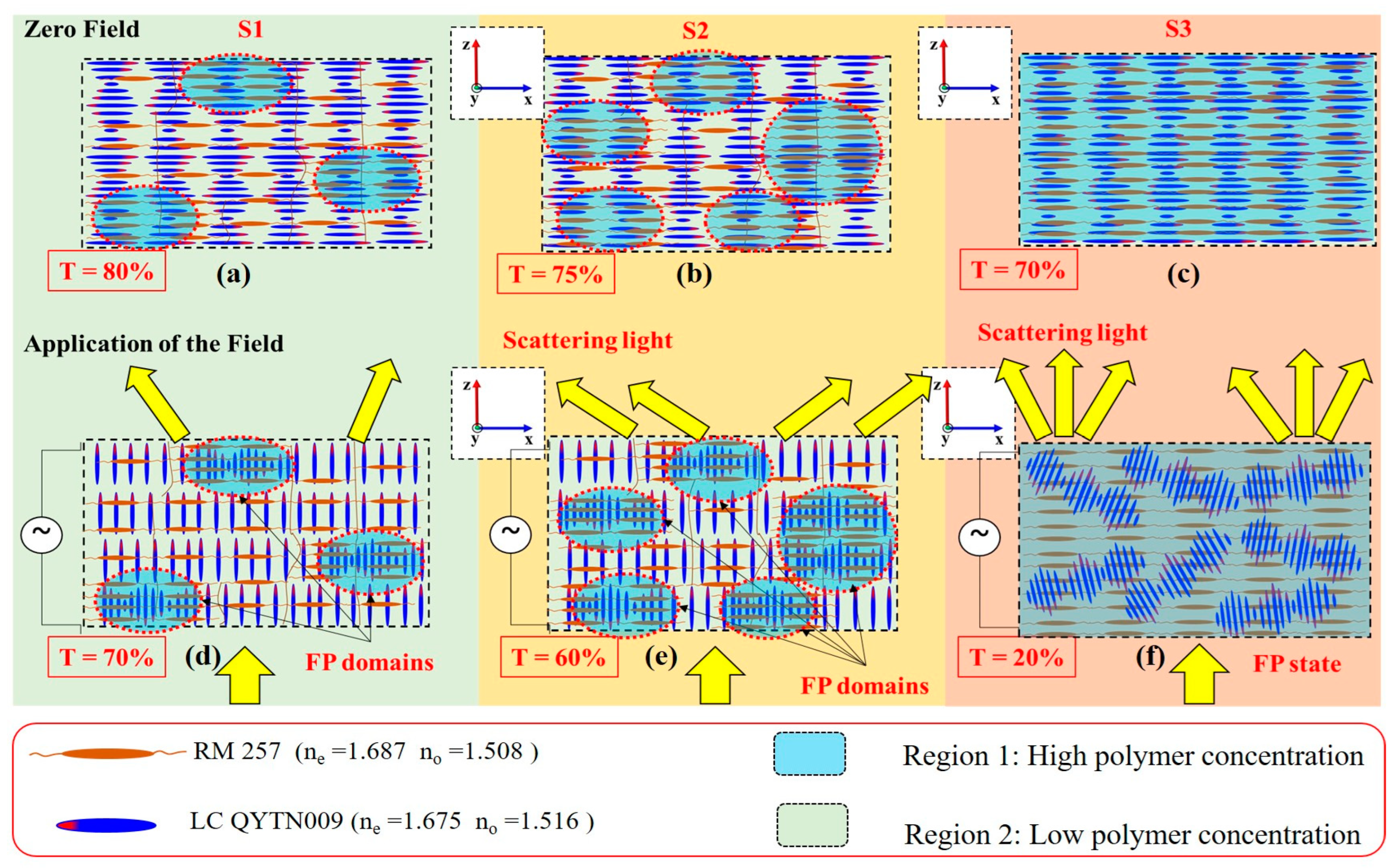

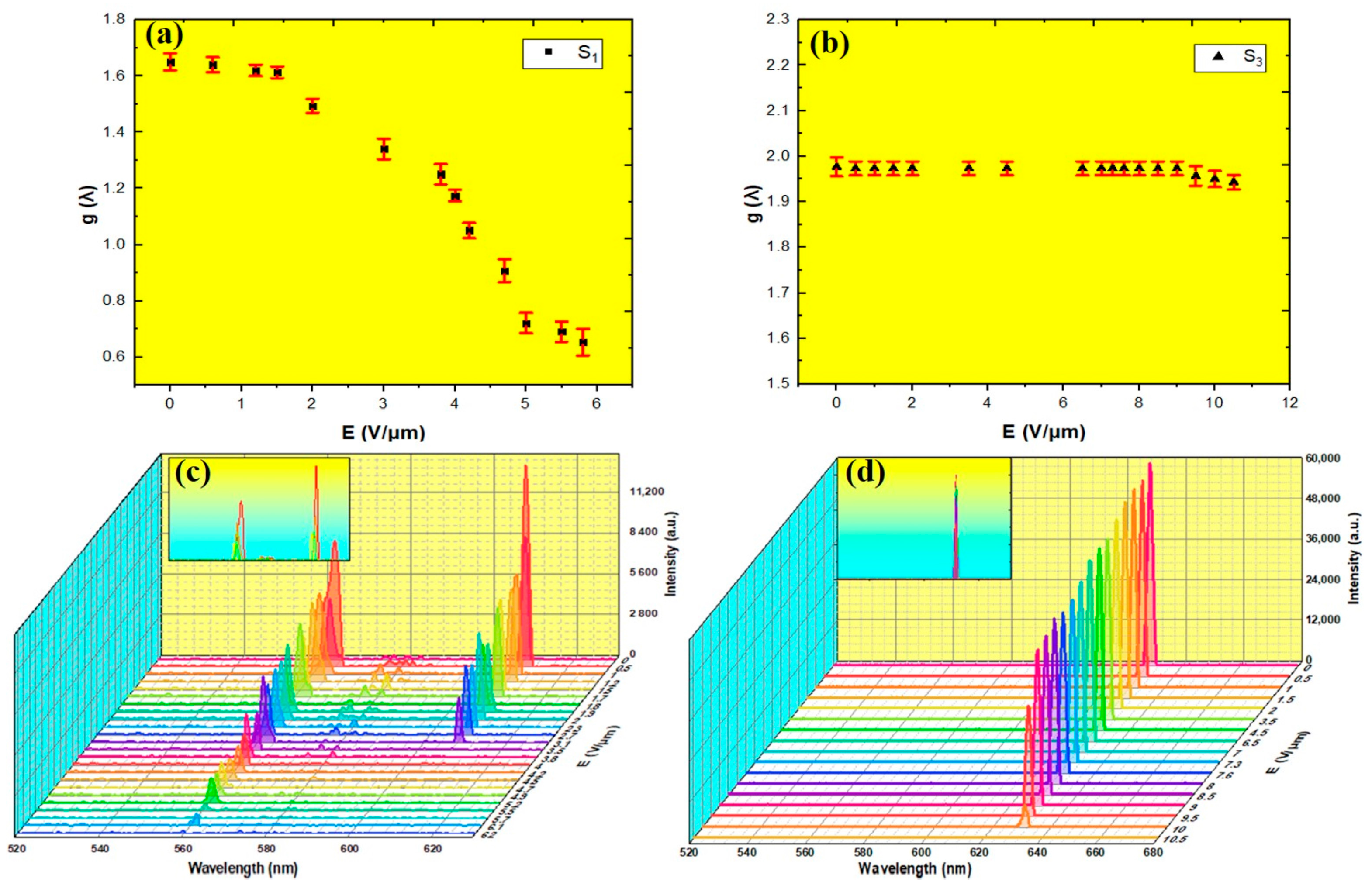
| CLC | PCLC | ||||
|---|---|---|---|---|---|
| Nematic | Chiral Dopant | CLC | Achiral Monomer | P. Initiator | |
| QYTN-009 | R5011 | QYTN-009 + R5011 | RM257 | Irg651 | |
| Sample 1 | 97.5 wt % | 2.5 wt % | 96 wt % | 3 wt % | 1 wt % |
| Sample 2 | 93 wt % | 6 wt % | 1 wt % | ||
| Sample 3 | 89 wt % | 10 wt % | 1 wt % | ||
| Samples | EFP (V/μm) | EFC (V/μm) | EH (V/μm) |
|---|---|---|---|
| S0 | - | 0.74 | 1.5 |
| S1 | - | 4 | 9 |
| S2 | - | 5 | 10 |
| S3 | 6 | 8 / 9 | 12 |
Disclaimer/Publisher’s Note: The statements, opinions and data contained in all publications are solely those of the individual author(s) and contributor(s) and not of MDPI and/or the editor(s). MDPI and/or the editor(s) disclaim responsibility for any injury to people or property resulting from any ideas, methods, instructions or products referred to in the content. |
© 2024 by the authors. Licensee MDPI, Basel, Switzerland. This article is an open access article distributed under the terms and conditions of the Creative Commons Attribution (CC BY) license (https://creativecommons.org/licenses/by/4.0/).
Share and Cite
Saadaoui, L.; Yang, D.; Hassan, F.; Qiu, Z.; Wang, Y.; Fan, Y.; Drevensek-Olenik, I.; Li, Y.; Zhang, X.; Xu, J. Electro-Optic Response of Polymer-Stabilized Cholesteric Liquid Crystals with Different Polymer Concentrations. Polymers 2024, 16, 2436. https://doi.org/10.3390/polym16172436
Saadaoui L, Yang D, Hassan F, Qiu Z, Wang Y, Fan Y, Drevensek-Olenik I, Li Y, Zhang X, Xu J. Electro-Optic Response of Polymer-Stabilized Cholesteric Liquid Crystals with Different Polymer Concentrations. Polymers. 2024; 16(17):2436. https://doi.org/10.3390/polym16172436
Chicago/Turabian StyleSaadaoui, Lotfi, Donghao Yang, Faheem Hassan, Ziyang Qiu, Yu Wang, Yujie Fan, Irena Drevensek-Olenik, Yigang Li, Xinzheng Zhang, and Jingjun Xu. 2024. "Electro-Optic Response of Polymer-Stabilized Cholesteric Liquid Crystals with Different Polymer Concentrations" Polymers 16, no. 17: 2436. https://doi.org/10.3390/polym16172436






